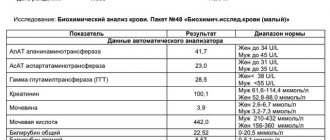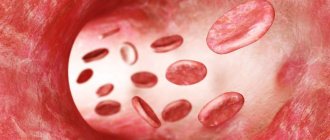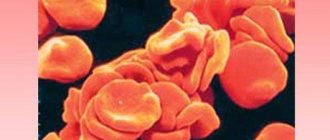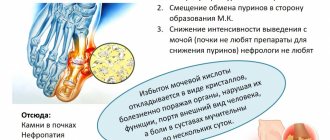| Name of service | Service price, rub. |
| Blood test for total protein | 260 |
Protein in human blood performs two main functions:
- Transport (it is performed by albumin proteins) - the protein transports various molecules to organs and tissues.
- Immune (performed by globulin proteins) – protection against viruses and bacteria.
The term “total protein” refers to the concentration of total protein (albumin + globulins) in the liquid part of the blood. Globulins are produced by the liver and immune system. Albumin is the main blood protein produced in the liver.
Our clinic constantly hosts promotions
Blood test for total protein
Determining the concentration of proteins in plasma provides important information about the general state of health, the functioning of vital organs and the course of pathological processes. The analysis is carried out as part of a biochemical blood test, which also includes cholesterol, liver function tests, kidney function tests and glucose (measured in mmol/l)¹.
Blood proteins are a special buffer system that maintains the acid-base balance of the plasma in an optimal state - pH 7.37-7.43.² They also affect the viscosity and coagulability of the blood.
In biochemical analysis, the indicator is designated as total protein in the blood (T-Prot) or Total Protein. The laboratory result is given in grams per liter (g/l). In a detailed study, the quantity and percentage of different protein fractions (proteinogram)² are calculated. For analysis, blood is taken from the cubital vein or the vein on the back of the hand.
Proteins account for 6.5-8.5% of the total dry residue of plasma (9-10%)¹. Concentration depends on the rate of their synthesis and destruction, as well as the volume of distribution in bodily fluids and tissues. The indicator may change during the day, after physical activity and a large meal.
Patients are referred for analysis by a therapist or doctor of any other specialty, since total protein is not a specific indicator. Protein metabolism disorders occur with any inflammation, infections, diseases of internal organs and oncology. In rare cases, patients have congenital disorders of protein production.
To test for total protein, blood is taken from the cubital vein. Photo: tridsanu1984 / freepik.com
Indications for analysis
A study of total protein in the blood may be prescribed for the following indications³:
- general clinical medical examination;
- primary search for pathology of metabolic processes (metabolism);
- unexplained weight loss;
- swelling of the limbs, face;
- fatigue and severe weakness that does not correspond to the load;
- unexplained shortness of breath;
- the appearance of complaints from the liver or kidneys: chronic fatigue, arterial hypertension, increased abdominal volume due to intra-abdominal fluid, jaundice, pale skin, changes in the daily pattern of urination;
- eating problems, including eating disorders (anorexia, bulimia);
- suspicion of pregnancy;
- presence of signs of exhaustion;
- preventive examination for athletes, workers in heavy industries;
- monitoring the treatment or progress of diseases of internal organs;
- preparation for any surgical intervention.
Testing for total protein in the blood is the first step in diagnosing many diseases of internal organs and metabolic disorders. If the values deviate, the patient is referred for clarifying tests: determination of albumin or all protein fractions (proteinogram), leukocyte formula, erythrocyte sedimentation rate (ESR), hematocrit².
Data on nitrogen metabolic processes
A too slow metabolic process, fasting, polyuria or liver failure will be indicated by an underestimation of creatinine, urea, and uric acid in the blood. Normal blood biochemistry values increase the likelihood of problems with the diseases in question.
An overestimation of urea is also possible. If it is found during blood biochemistry, then arterial hypertension, poisoning or kidney disease will be suspected. Readings above normal for uric acid are a sign of poisoning, infectious diseases, skin pathologies, gout, leukemia or diabetes. One of the signs of abnormalities in kidney function is also high creatinine. The indicator also signals diabetes mellitus, muscular dystrophy or obstruction in the intestinal area.
Preparing for analysis
A visit to the laboratory must be planned in advance, since the informativeness of the laboratory report depends on the quality of preparation. The following rules must be observed the day before:
- the day before the study, give up alcoholic beverages, heavy physical activity and stop taking medications (after consultation with your doctor);
- 2-3 days before the test, limit the consumption of fatty foods, smoked foods, pickles, and confectionery;
- do not visit baths, saunas, or solariums for several days before the procedure, and the day before replace the hot bath with a hygienic shower;
- do not smoke for 3 hours before donating blood, avoid psycho-emotional overload;
- 15 minutes before donating blood, you need to calm down and relax;
- the last meal in 12 hours - the night before in the form of a light dinner;
- In the morning you can only drink water (even juices and chewing gum are prohibited).
Important!
Total protein in the blood is the sum of all proteins. May show false results if improperly prepared, dehydrated, or after physical activity. It also does not provide information about isolated changes in the ratio of different fractions - albumins, globulins³.
The following factors also influence protein content³:
- pharmaceuticals containing sex hormones (testosterone, estrogens, oral contraceptives), phenothiazines;
- high physical activity can temporarily increase concentration by up to 10%;
- dietary patterns (for example, vegetarians who do not take special nutritional supplements have fewer circulating proteins in the serum);
- pregnancy;
- environment - people who live in warm countries have more immunoglobulins than residents of cold climates;
- damage to internal organs leads to massive loss of the protein part;
- change in circulating blood volume;
- any inflammation;
- improper storage of reagents and biological material;
- error of a specific research method;
- method of collecting material - long-term application of a tourniquet before taking blood from a vein increases the amount of protein in the serum.
Plasma protein concentrations are variable and change rapidly during the day under the influence of external factors. It increases by 10-20% if you stand up suddenly after lying down for a long time and then take the test 30 minutes later.
The study is carried out on an empty stomach, in the morning. You should not visit the laboratory after massage or physiotherapeutic procedures. Any effects on the body, including radiological ones, must be excluded before analysis³.
Figure 1. Norm of total protein and its fractions. Source: MedPortal
Blood protein levels
Normal indicators for children and adults differ.
Each laboratory sets its own standards (reference values), which depend on the hardware and test methodology. Therefore, to monitor the effectiveness of prescribed therapy, it is recommended to use the services of one medical or diagnostic institution. Table 1. Norms of total protein in a biochemical blood test³
| Age | Norms for men and women, g/l |
| Premature | 36-60 |
| Newborns | 48-73 |
| In children 1-2 years old | 56-75 |
| For children 2-14 years old | 60-80 |
| Over 14 years old and adults | 65-85 |
Women and men do not have a significant clinical difference in blood protein levels⁵. By about the age of three, the amount of proteins in the serum of children and adults becomes almost the same.
Proteins in the human body are produced and broken down continuously: they are constantly renewed. In addition to hormonal and physical factors, this process is influenced by the nature of nutrition, heredity, and the presence of concomitant diseases.
Important!
The norms may deviate slightly in healthy women during menstrual bleeding, pregnancy and breastfeeding. A decrease in total protein to 55-65 g/l during pregnancy is not considered a pathology³.
Albumen
The total protein consists of 50-70% albumin, which determines the oncotic pressure of plasma². With their isolated decrease (hypoalbuminemia), fluid leaves the vascular bed into the tissues and body cavities without returning back. The same mechanism underlies the development of hungry edema.
Albumin performs a transport function, provides cells with necessary amino acids and takes part in maintaining a constant internal environment. The normal content of albumin in the plasma of an adult is 30-50 g/l.² Liver cells produce approximately 12 g of this protein² per day.
Globulins
Globulin molecules have a larger molecular weight than albumins and are less soluble in water. These include specific serum proteins, enzymes, hormones, antibodies (immunoglobulins). Synthesized in the liver and immunocompetent organs.
Almost 35-50% of total protein consists of globulins. Below are the normal values for the main fractions²:
- alpha1-globulins - 1-3 g/l (3-6%);
- alpha2-globulins - 6-10 g/l (9-15%);
- beta globulins - 7-11 g/l (8-18%);
- gamma globulins (immunoglobulins IgA, IgM, IgG) – 8-16 g/l (15-25%);
When the ratio of serum proteins changes, dysproteinemia develops. Each of the fractions has its own functions and properties, therefore, by the deviation of their quantity, one can suspect the cause of the disorders or even a specific disease.
The severity of dysproteinemia is assessed using the albumin-globulin coefficient (ratio of fractions). In healthy people, this value does not exceed 2.5-3.5. With liver cirrhosis or chronic hepatitis, the indicator decreases to 1-1.5 due to impaired albumin production in liver cells¹.
What it is?
C-reactive protein is a two-component molecule consisting of proteins (peptides) covalently linked to several oligosaccharides. The name is due to its ability to interact with C-polysaccharides of bacteria of the Streptococcaceae family, thereby forming a stable antigen-antibody complex (precipitation reaction). This mechanism refers to the protective reactions of the human body to infectious infection.
When a pathogen penetrates, the immune system is activated, which stimulates the process of synthesis of small peptide molecules - cytokines. They provide signal transmission about the manifestation of the inflammatory process and the need to enhance the production of acute phase proteins, which are CRP. After 1-2 days, there is an increase in CRP by tens and hundreds of times compared to normal values.
Causes of high protein
An increase in the amount of serum proteins is called hyperproteinemia. It can be absolute (impaired protein production due to organ damage) and relative (associated with changes in plasma volume).
Possible causes of hyperproteinemia²:
- severe dehydration (profuse diarrhea and/or vomiting, ketoacidosis in diabetes mellitus, insufficient water intake, massive sweating);
- extensive burns;
- autoimmune diseases, in which the body begins to produce a large amount of protein immunoglobulins that attack its own organs (rheumatism, systemic lupus erythematosus, sarcoidosis);
- Hodgkin's lymphoma (lymphogranulomatosis) - malignant lesion of lymphoid tissues;
- tumors of the blood and lymphatic system;
- chronic hepatitis in the active phase;
- liver cirrhosis in the initial stages;
- Waldenström's macroglobulinemia is a tumor that primarily affects the bone marrow and produces large amounts of monoclonal immunoglobulin M (IgM);
- peritonitis - active inflammation of the peritoneum;
- intestinal obstruction;
- kidney pathology in the phase of polyuria (excessive urination);
- cholera is an acute infectious disease (especially dangerous), accompanied by damage to the small intestine, massive diarrhea, vomiting and severe dehydration;
- acute and chronic infections.
Important!
Severe hyperproteinemia leads to impaired blood viscosity and improper circulation through the vessels. The most dangerous outcome is disseminated intravascular coagulation syndrome (DIC), in which thrombosis alternates with bleeding.
Data on microelements and vitamins
Often, normal blood biochemistry levels are checked when clarifying vitamin levels in men or women. Attention should be paid to sodium and potassium. If there is too much sodium, you may experience muscle cramps, irritability and excessive thirst. A minimal amount of the element leads to headaches, the desire to constantly sleep, vomiting, and coma.
If potassium is elevated, arrhythmia, underestimation of blood pressure, and confusion are possible. Vomiting and nausea are signs of low potassium, and sometimes the condition leads to involuntary bowel movements or urination.
Causes of low protein
Hypoproteinemia is a decrease in the concentration of proteins in the blood. Most often associated with the direct loss of proteins, starvation or inhibition of their synthesis, that is, production in organs.
After surgery, the amount of protein in the blood is reduced. Photo: photography33/Depositphotos
There are the following causes of hypoproteinemia¹:
- burn disease;
- prolonged overheating of the body (hyperthermia), including febrile states;
- diabetes;
- bleeding;
- thyrotoxicosis - hyperfunction of the thyroid gland;
- prolonged physical activity;
- recovery after surgery;
- oncological diseases;
- kidney damage with the development of nephrotic syndrome;
- loss of protein due to inflammation of the intestinal mucosa (enteritis);
- liver damage with signs of cellular failure due to hepatitis, cirrhosis, poisoning (toxic substances, alcohol, medications);
- insufficient intake of protein from food, fasting, exhausting diets, strict vegetarianism);
- impaired absorption of protein foods during pancreatitis (inflammation of the pancreas), intestinal resection (malabsorption syndrome);
- increased breakdown of proteins due to injuries, infectious diseases, Cushing's syndrome;
- inflammatory bowel diseases;
- movement of proteins from the vascular bed into the abdominal (ascites) or pleural cavity (pleurisy);
- severe heart failure;
- inadequate volume of infusion therapy through droppers, resulting in a sharp increase in circulating blood;
- Parhon's syndrome (antidiabetes insipidus) - a violation of vasopressin production due to hyperfunction of the hypothalamic-pituitary system in the brain;
- congenital deficiency of gamma globulins or other protein fractions.
A decrease in the protein portion of plasma can lower oncotic pressure, resulting in the development of edema. The fluid passes from the vessels into the tissues and cavities of the body. This disrupts the nutrition of the vascular wall and blood clotting.
Important!
Total protein levels below 40 g/l are life-threatening³!
Treatment begins after determining the cause of the deviation from the norm. Drug therapy is selected by the attending physician in accordance with the diagnosis, the severity of the patient’s condition, and concomitant diseases.
What do deviations from the norm indicate?
Quite often it is necessary to take a test such as blood biochemistry, so for many it is important to decipher the data obtained and normal indicators for comparison with those obtained in the laboratory. At the same time, the presence of any deviations does not indicate the fact of certain health problems, so it is worth finding out all the nuances from the doctor. The numbers are considered in aggregate and separately; they can only indirectly indicate the presence of possible diseases or deviations from the ideal state. We suggest studying normal blood biochemistry indicators, the reasons for underestimated or excessively high data in women or men.
How to reduce or increase protein in the blood
Therapeutic diets with high or low protein content are selected by a nutritionist in accordance with the patient’s diagnosis. In case of minor deviations from the norm, the problem can be solved by self-correction of the diet.
What foods increase protein in the blood?
A high-protein diet involves consuming 110-120 g of protein per day⁶. Prescribed for patients with diabetes, kidney disease, severe anemia and sepsis.
Important!
Animal products (dairy products, meat and fish) are a natural source of proteins and essential amino acids, which are absorbed by more than 90%. They should make up 50% of the total amount of protein in the daily diet of an adult, 60% for children⁷.
The diet includes the following easily digestible protein sources:
- lean beef, veal;
- rabbit;
- skinless chicken;
- turkey;
- boiled tongue;
- trimmed pork without fat;
- moderately fatty fish varieties, preferably sea or red;
- milk;
- fermented milk drinks;
- cottage cheese;
- sour cream;
- hard cheese;
- eggs (chicken, quail);
- legumes in the form of cereals, in salads;
- mushrooms (with normal tolerance);
- quinoa;
- seeds, sesame;
- tofu;
- nuts;
- soy milk;
- green vegetables.
You can increase protein in the blood with the help of high-protein foods. Photo: antoninavlasova / freepik.com
What foods reduce protein in the blood?
When serum total protein levels are elevated, a low protein diet is followed. Protein consumption is temporarily limited to 20-60 g/day until its level is normalized according to the results of a control blood test. You cannot completely eliminate proteins from your diet without consulting a doctor.
Low-protein nutrition is indicated for severe liver cirrhosis and chronic renal failure. As compensation, the diet is enriched with vitamins and minerals. Drinking plenty of water can naturally reduce protein (berry fruit drinks, compotes, teas). If there is an urgent need, red meat is replaced with white (poultry fillet) along with a large amount of vegetables and fruits.
Sources
- Laboratory tests for the study of specific proteins / Ed. Yu.I. Yarets. Gomel. 2015. 64 p.
- Proteins in blood and urine. Analysis of proteinograms and clinical diagnostic significance. Candidate of Biological Sciences, Associate Professor Gorelaya M.V. Dnepropetrovsk 2015.
- Clinical laboratory diagnostics: textbook / Ed. V.V. Dolgova, Federal State Budgetary Educational Institution of Further Professional Education "Russian Medical Academy of Continuing Professional Education". – M.: FGBOU DPO RMANPO. 2021. – 668 p. ISBN 978-5-7249-2608-9
- Clinical laboratory diagnostics: teaching method. manual for students of medical, pediatric and medical-psychological faculties / S.V. Lelevich, V.V. Vorobiev, T.N. Grinevich – Grodno: GrSMU, 2011. – 166 p.
- Abumuslimov S.S., Magomedova Z.A. Total protein and protein fractions in blood donors in Grozny according to automated analysis // Bulletin of KrasGAU. 2021. No. 6.
- National Association for Clinical Nutrition. Clinical recommendations for the diagnosis and correction of nutritional disorders. Moscow 2013.
- MP 2.3.1.2432-08 Norms of physiological needs for energy and nutrients for various groups of the population of the Russian Federation.
- Druzhinina, N. A. Malnutrition in childhood / Druzhinina N. A. - Moscow: GEOTAR-Media, 2021. - 160 p. — ISBN 978-5-9704-5164-9.









